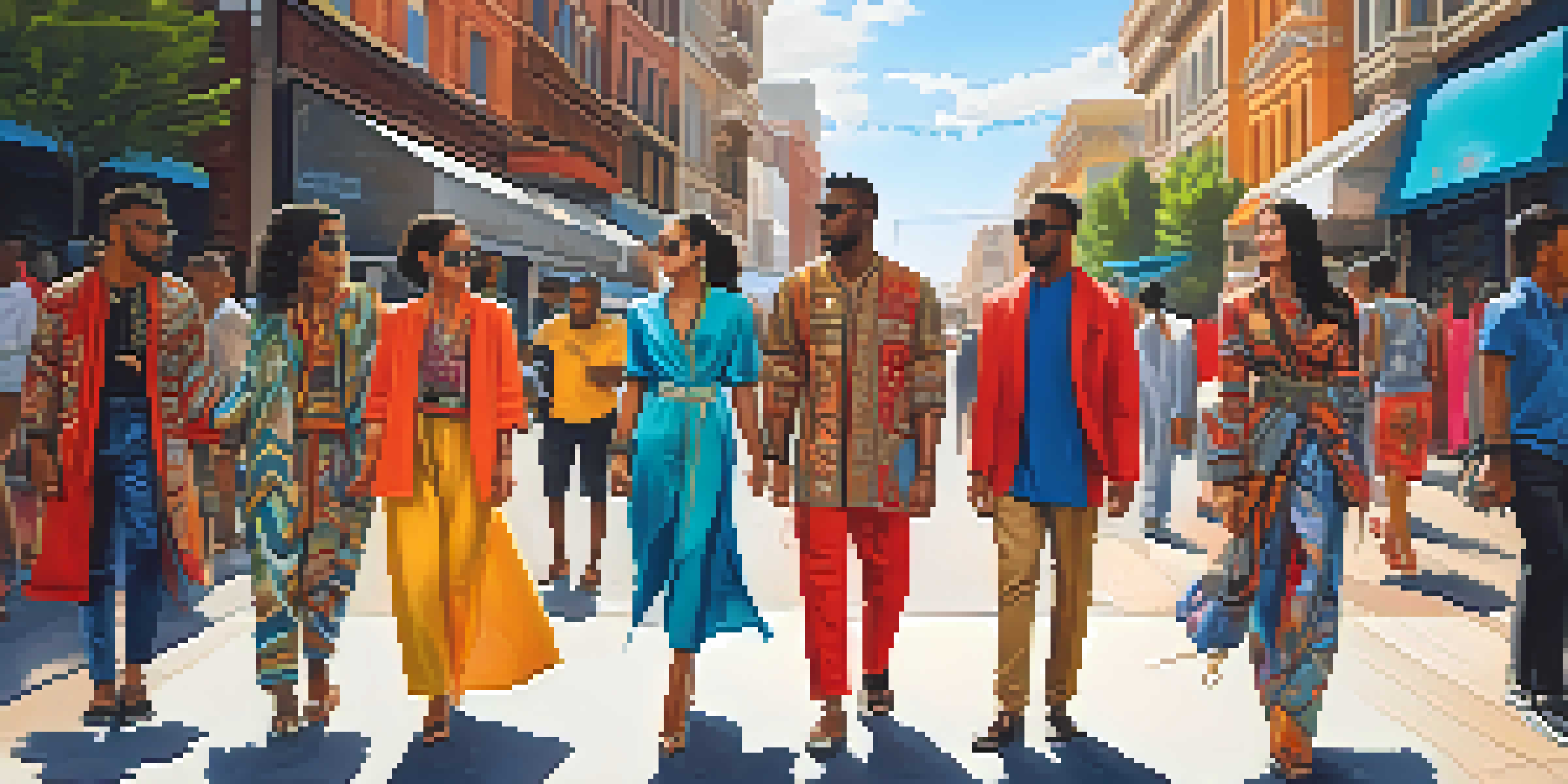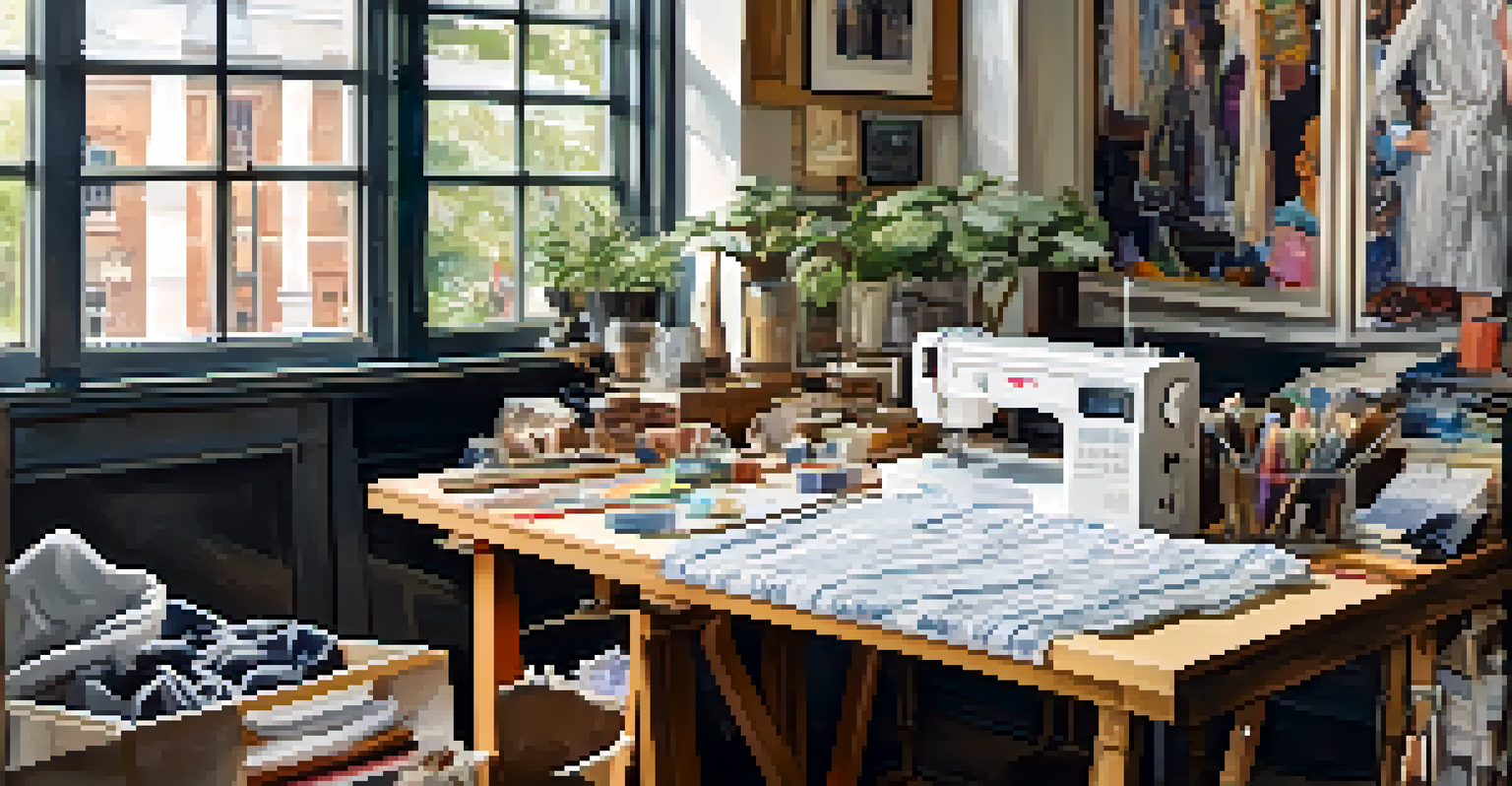The Evolution of Fashion as an Expression of Culture

Fashion as a Reflection of Historical Context
Throughout history, fashion has served as a mirror reflecting the values and events of its time. For instance, the opulence of the Victorian era showcased a society that valued class distinction and decorum. In contrast, the flapper dresses of the 1920s symbolized a break from tradition, embracing freedom and modernity. Such shifts in fashion illustrate how clothing often embodies the spirit of the age.
Fashion is the armor to survive the reality of everyday life.
From the French Revolution's simpler styles to the bold silhouettes of the 1980s, each fashion trend tells a story about the social and political climates of its era. These examples demonstrate that fashion is not just about aesthetics; it's intertwined with historical narratives. It allows us to understand the collective identity and aspirations of people across generations.
As we look back, we can see how major events like wars, economic shifts, and cultural movements have influenced what people wear. This connection between fashion and history helps us appreciate not only the garments themselves but also the stories behind them, enriching our understanding of cultural evolution.
Cultural Influences Shaping Fashion Trends
Cultural influences play a significant role in shaping fashion trends, as different societies bring their unique aesthetics and traditions to the forefront. For example, the vibrant patterns of African textiles have inspired countless designers, infusing contemporary fashion with rich history and artistry. Similarly, Japanese street fashion has gained global recognition, blending traditional elements with modern flair.

These cultural exchanges highlight the beauty of diversity in fashion, as designers often draw inspiration from various backgrounds to create something new. Not only does this enrich the fashion landscape, but it also fosters a sense of global community. When we wear clothing inspired by different cultures, we celebrate and honor those traditions.
Fashion Mirrors Historical Context
Fashion reflects societal values and events, showcasing shifts in culture and identity through different eras.
Moreover, the rise of social media has accelerated the sharing of diverse fashion influences, allowing trends to spread rapidly across borders. This interconnectedness has made fashion a truly global language, one that transcends geographical boundaries and unites people through shared styles and inspirations.
The Role of Technology in Fashion Evolution
Technology has been a driving force in the evolution of fashion, reshaping how we create, distribute, and consume clothing. The invention of the sewing machine in the 19th century revolutionized garment production, making clothing more accessible and affordable for the masses. Fast forward to today, and digital innovations have transformed the industry yet again, with online shopping and virtual fitting rooms becoming the norm.
Style is a way to say who you are without having to speak.
Moreover, technology has given rise to sustainable fashion practices, enabling designers to create eco-friendly garments using innovative materials and methods. As consumers become more conscious of their impact on the planet, technology offers solutions that align with their values. This shift not only changes how we dress but also influences the entire fashion supply chain.
Additionally, social media platforms serve as powerful tools for fashion marketing, allowing brands to reach global audiences instantly. Influencers and fashion bloggers play a crucial role in shaping trends, showcasing how technology has democratized fashion. As we embrace these advancements, we must also consider their implications for culture and identity.
Fashion as a Means of Personal Expression
Fashion has always been a powerful means for individuals to express their identities and beliefs. The way we dress often reflects our personalities, values, and even our moods. For many, choosing an outfit can be as significant as a form of art, allowing them to communicate who they are without saying a word.
Consider how subcultures like punk, goth, or hip-hop use fashion to convey their distinct identities and social messages. Each style serves as a bold statement, challenging societal norms and expectations. Through their clothing choices, individuals can assert their beliefs and connect with like-minded communities, fostering a sense of belonging.
Cultural Influences Shape Trends
Diverse cultural aesthetics enrich fashion, fostering global community and celebrating unique traditions.
In today's world, where self-expression is celebrated, fashion continues to evolve as a canvas for individuality. Social media platforms have amplified this trend, encouraging people to showcase their unique styles and creativity. As we embrace our differences through fashion, we contribute to a richer, more inclusive cultural landscape.
The Influence of Globalization on Fashion
Globalization has fundamentally transformed the fashion industry, creating a complex web of influences that shape trends worldwide. As borders blur, cultural exchange accelerates, allowing fashion styles from one corner of the world to inspire another. For instance, Western fashion has borrowed elements from Eastern traditions, resulting in hybrid styles that celebrate cultural diversity.
This interconnectedness has led to the rise of fast fashion, where trends emerge and evolve at breakneck speed. While this model offers affordability and variety, it also raises questions about sustainability and ethical practices in the industry. As consumers, we must navigate these complexities, balancing our desire for trendy clothing with the responsibility to support ethical production.
Moreover, globalization has amplified the voice of local artisans and designers, allowing them to share their craftsmanship on a global stage. As we explore fashion from different cultures, we gain a deeper appreciation for the stories and traditions behind each piece. This journey not only enriches our wardrobes but also fosters a greater understanding of the world around us.
The Impact of Social Movements on Fashion
Social movements have profoundly influenced fashion, serving as catalysts for change and reflection. The feminist movement, for example, has redefined women's fashion, challenging traditional notions of femininity. The shift from constricting corsets to comfortable yet stylish attire symbolizes women's liberation and empowerment.
Similarly, the LGBTQ+ rights movement has inspired fashion to embrace diversity and inclusivity. Designers are increasingly celebrating gender fluidity, creating collections that transcend traditional gender norms. This evolution in fashion highlights how clothing can be a powerful tool for advocating social change.
Social Movements Drive Fashion Change
Fashion evolves in response to social movements, promoting inclusivity and challenging traditional norms.
As we witness these shifts, it's essential to recognize the role that fashion plays in amplifying voices and promoting social awareness. Each garment has the potential to tell a story, sparking conversations about identity, culture, and equality. By understanding the impact of social movements on fashion, we can appreciate its power to drive progress and foster inclusivity.
The Future of Fashion in a Changing World
As we look to the future, fashion will continue to evolve in response to cultural, technological, and environmental changes. The conversation around sustainability is gaining momentum, prompting designers to rethink materials and production methods. This shift toward eco-conscious fashion reflects a growing awareness of our impact on the planet and the importance of responsible consumption.
Additionally, the rise of virtual fashion and digital clothing is changing how we perceive and consume style. As virtual reality and augmented reality technologies advance, we may find ourselves wearing digital garments in virtual spaces, blurring the lines between physical and digital fashion. This evolution opens up new avenues for creativity and expression, challenging traditional notions of what clothing can be.

Ultimately, the future of fashion will be shaped by our collective values and choices. As consumers become more informed and engaged, they will drive the demand for ethical practices and innovative designs. By embracing change and celebrating diversity, we can create a fashion landscape that reflects our shared humanity and cultural richness.